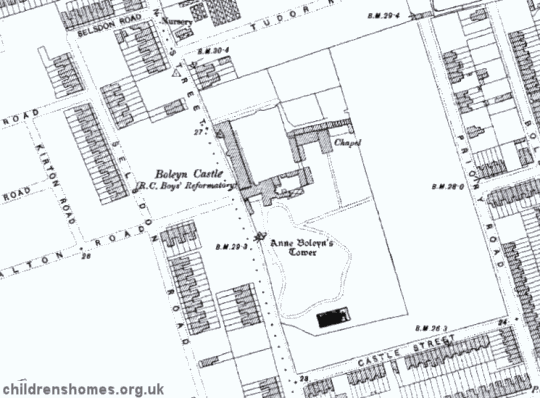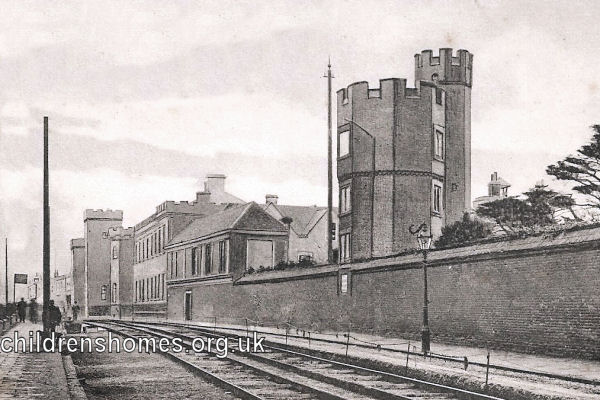St Edward's Reformatory for Roman Catholic Boys, Plaistow, East Ham, Essex
On October 28th, 1870, St Edward's Reformatory for Roman Catholic Boys was certified to begin operation in premises known as Boleyn Castle on Green Street, Upton Park in Plaistow / East Ham. The property had been purchased for the purpose by Cardinal Manning in 1869 to replace the reformatory at Brook Green whose location and arrangements had proved unsatisfactory.
The location of the School is shown on the 1896 map below.

St Edward's Reformatory for Roman Catholic Boys site, Plaistow, c.1896.

St Edward's Reformatory site from the south, Plaistow, c.1905. © Peter Higginbotham
The School, which was run by the Brothers of the Order of Mercy, could accommodate 220 boys, aged 12 to 16 years at their date of admission.
The School appears to have had a good reputation, as illustrated by this 1889 inspection report:
Number of inmates on day of inspection, boys, 141, and 12 on license.
State of premises.—This reformatory continues to be carried on with ability and success. There is very good accommodation in every particular. A fine open yard, large garden, about five acres of farming land. The dormitories are spacious and well ventilated. There are excellent workshops and good class-rooms. There is a good bath. I found all the buildings in good repair end under careful supervision.
Health and general condition.—The health of the boys had been good. Very little seriously wrong. A few cases of skin disease, strumous glands; one or two cases of ophthalmia; two phthisis; one tonsillitis. No death since last inspection. The boys looked healthy and strong, properly fed and well clothed.
Conduct and discipline.—The lads had given very little trouble in the year. They are rationally treated, and have no reason for complaint. A few cases of disorder and fighting. Some passionate and bad language, occasional outbreaks of bad temper, and impertinence, disobedience, and idleness. The boys were well in hand and were well disposed. They are managed with much tact and rare experience.
Educational state.—This is carefully attended to. 28 in Standard Five: an intelligent class; all doing well; good work, and very few failures. 28 in Standard Four: a superior class, carefully instructed; excellent progress and satisfactory results. 40 in Lower Four: the work was accurately done; very few defects, and much care. 23 in Standard Three: a very satisfactory class. 10 in Standard Two and 4 in Standard One: all progressing well. All the boys behaved remarkably well, and were respectful, quiet, and under perfect control.
Industrial training.—This is steadily carried on. I found 40 boys working with the tailor, and good even work turned out. 15 with the shoemaker, good work under a careful workman. A class of juniors knit the hose and repair clothing. The boys bake all their own bread under a baker. There is a large garden, and a class of boys attend to the stock and the farming work. An excellent band gave me some good music.
Staff.—Superintendent, Brother Dominick; and seven Brothers of the Order of Mercy; tailor, shoemaker, baker, gardener, farm bailiff, and cattleman.
Average number maintained, 146.
In 1906, the School relocated to premises previously occupied by the St John's Industrial School at Walthamstow and which was then renamed the St John's Reformatory School.
The Boleyn Castle premises were used from 1907 to 1912 as a maternity home, and then until the Second World War as a social club. The buildings were demolished in 1955. St Edward's Catholic Primary School now occupied the site.
Records
Note: many repositories impose a closure period of up to 100 years for records identifying individuals. Before travelling a long distance, always check that the records you want to consult will be available.
- Catholic Children's Society (Westminster) [formerly the Crusade of Rescue], 73 St Charles Square, London W10 6EJ.
Census
Bibliography
- Carpenter, Mary Reformatory Schools, for the Children of the Perishing and Dangerous Classes, and for Juvenile Offenders (1851, General Books; various reprints available)
- Carlebach, Julius Caring for Children in Trouble (1970, Routledge & Kegan Paul)
- Higginbotham, Peter Children's Homes: A History of Institutional Care for Britain's Young (2017, Pen & Sword)
- Abel Smith, Doroth Crouchfield: A History of the Herts Training School 1857-1982 (2008, Able Publishing)
- Garnett, Emmeline Juvenile offenders in Victorian Lancashire: W J Garnnett and the Bleasdale Reformatory (2008, Regional Heritage Centre, Lancaster University)
- Hicks, J.D. The Yorkshire Catholic Reformatory, Market Weighton (1996, East Yorkshire Local History Society)
- Slocombe, Ivor Wiltshire Reformatory for Boys, Warminster, 1856-1924 (2005, Hobnob Press)
- Duckworth, J.S. The Hardwicke Reformatory School, Gloucestershire (in Transactions of the Bristol and Gloucestershire Archaeological Society, 1995, Vol. 113, 151-165)
Links
- Red Lodge Museum, Bristol — a former girls' reformatory.
Except where indicated, this page () © Peter Higginbotham. Contents may not be reproduced without permission.


